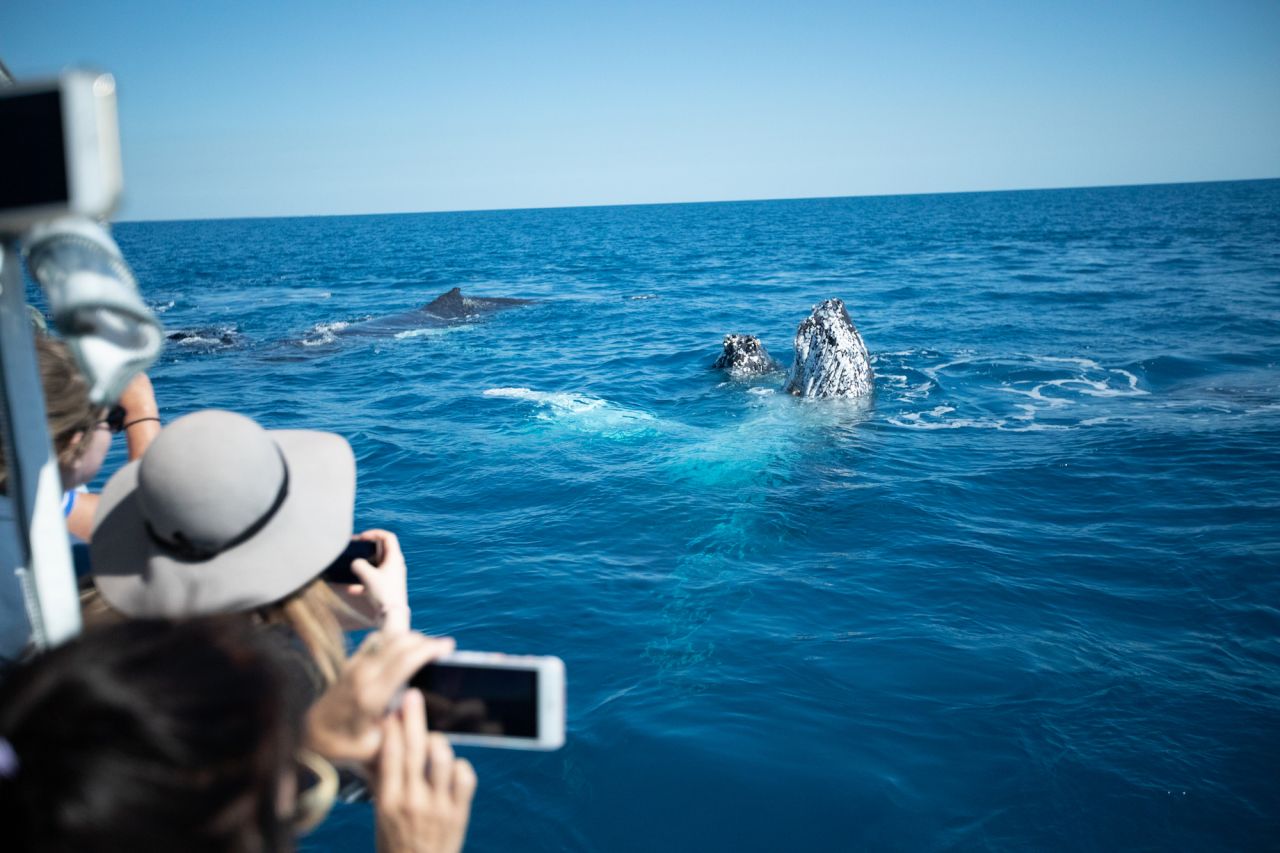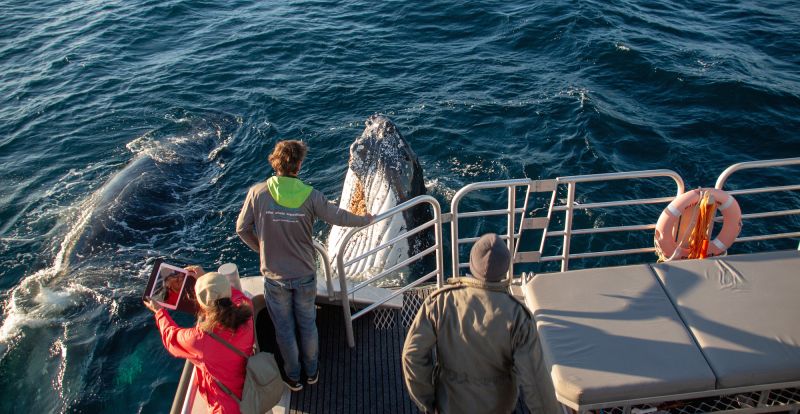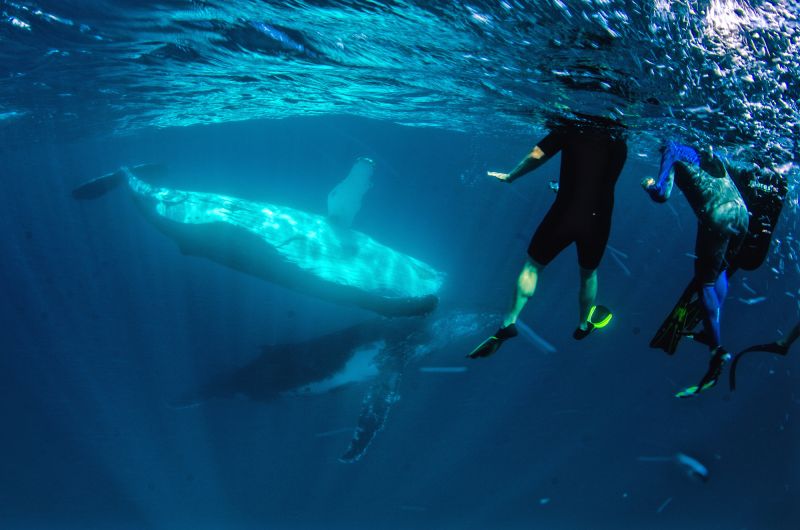Each January, around 60,000 Humpback Whales leave the frigid, food-rich waters of Antarctica and begin the world's longest mammal migration, a 5,000-kilometre, three-month journey to the warm waters of northern Australia where they mate, calve, and nurture their newborns.
Around 25,000 of these whales diverge around Tasmania and head up the east coast of Australia to Hervey Bay in Queensland, while the other 35,000 or so travel up the west coast past Margaret River coast, Exmouth & the Ningaloo Reef, and as far as Exmouth and the Kimberley.
Australia's Humpback Whale population has increased significantly from an estimated 200 animals when commercial whaling ceased in the 1960s to around 60,000 today, growing at a rate of 10-11.5% per year.
In Hervey Bay, the whales enjoy some of the calmest, most protected waters on their journey, where they are observed closely by marine biologists and eco-tour operators. Pacific Whale Foundation Eco-Adventures Australia, who conduct sustainable whale-watching tours focused on education and conservation, have developed the largest Humpback Whale database in Australia.
“We track Humpback Whales by photographing the underside of their tail fluke, where they have a unique pigmentation pattern,” explains Stephanie Stack, Chief Biologist at Pacific Whale Foundation. “Pacific Whale Foundation Eco-Adventures Australia is a social enterprise owned by Pacific Whale Foundation, and the profits from our marine eco-tours support whale and dolphin research, marine education for children, and ocean conservation programs. We are proud of our database, which is one of the biggest photo catalogues in the world and has over 6,900 individual Humpback Whale files.”
Stephanie explains that the identification program is an asset that is used beyond just finding individual whales. “We are using the photo identification program for longevity. We’re trying to learn how long the whales live for, since that is one question researchers do not know the answer to yet.”
Featured Tour: Ultimate Hervey Bay Whale Watching
Operator: Pacific Whale Foundation Eco-Adventures Australia
Departs: July - late October
Duration: 3 hours
Explore the world's first declared Whale Heritage Site at Hervey Bay, known for coming alive with thousands of Humpback Whales between July and October. This region is known for having some of the most active and inquisitive whales found anywhere across the globe, with breaches, whale songs and muggings common practice.

Meanwhile, 3,750 kilometres (2,300 miles) away on the opposite side of the Australian continent, Cape Leeuwin (Augusta) serves as the first resting point of the other group of Humpback migrants. "At the beginning of the season, we see competition pods of six to twelve males pursuing a single female in estrus," says Paul Cross, owner of Naturaliste Charters.
Observing Humpback Whales is an unforgettable experience, with the species often displaying a high level of curiosity towards the vessel. Guests are often left in awe as this marine mammal weighing 40 tons propels from the ocean's surface at high speed, in a spectacular breach.
The bulls are seen vying for attention in what often resembles a rugby scrum, using tactics like side-on ramming, head lunging, and fin-slapping. The mature adults are followed by the 'teenagers' and pregnant females.
Featured Tour: Augusta Whale Watching
Operator: Naturaliste Charters
Departs: May - mid August
Duration: 2.5 hours
The picturesque seaside town of Augusta is one of the best locations in Australia to view Humpback Whales as they make their epic migration north, filling the beautiful Flinders Bay area.

By mid-May, pregnant females arrive in Exmouth, 1,500 km north of Cape Leeuwin. Some remain there, while others continue to the Kimberley, using the reef for protection as they calve and mate. The calves, born around four meters long, grow rapidly over the next three months, consuming about 250 litres of their mother's milk each day.
The calm waters of Exmouth Gulf provide a final resting place until late October. "There are so many whales breaching and fin-slapping it's hard to know where to look," says Mark Ferguson, owner of Exmouth Dive & Whale Sharks Ningaloo, who leads tours that allow guests to observe these magnificent creatures in their natural environment.
Mark and his team offer full-day tours where guests can get in the water alongside the whales. Swimming with one Humpback is the goal, but since the whales often travel in twos, guests are sometimes able to swim with a mother and her calf, and even a male escort if they’re very lucky.
“The first time I swam with a Humpback Whale took my breath away and it felt like there was nothing else in the world except this giant of the ocean and me,” spotter and snorkelling guide, Corrine Matthews recalls. “I hear similar statements from guests after they experience their first swim, too. The adrenalin is high, but the minute you see a Humpback your body and mind just freeze in the moment.”
By September, when the calves are strong enough, it's time for the return journey south.
Featured Tour: Deluxe Mega Fauna Swim (Humpback or Whaleshark)
Operator: Exmouth Dive & Whalesharks Ningaloo
Departs: August - late October
Duration: Full day
Experience a snorkel on the beautiful Ningaloo Reef before heading out to swim with either the majestic Humpback Whale or the world's largest fish, the Whale Shark.

Their last rest stop before the long journey across the Southern Ocean back to Antarctica is Geographe Bay, near Cape Naturaliste. Naturaliste Charters relocates to Geographe Bay between September and early December to take advantage of the whale-watching season, observing immature males and pregnant females eager to feed after months without food.
Mothers and calves rest at Cape Naturaliste, conserving energy as they drift in the protected waters. "We're seeing whales arriving earlier and staying later," says Paul Cross. "It's now a strong, healthy, and stable population."
Featured Tour: Dunsborough Whale Watching
Operator: Naturaliste Charters
Departs: Mid August - late November
Duration: 2.5 hours
The tranquil waters off the beautiful town of Dunsborough, provide the perfect backdrop for travellers to regularly observe Humpback Whales, Southern Right Whales and the possibility of spotting the largest ever creature on earth, the Blue Whale, as they escort calves born in southward to Antarctica from October onwards.

Once on the brink of extinction, Humpback Whales have made an extraordinary comeback, making their migration one of the world's greatest wildlife conservation success stories.
Ready to embark on a Humpback Whale Watching adventure? Start your journey here!


